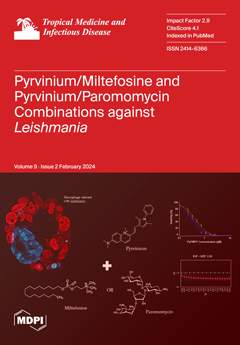Open AccessArticle
Determinants of Immunovirological Response among Children and Adolescents Living with HIV-1 in the Central Region of Cameroon
by
Rodolphe Steven Dobseu Soudebto, Joseph Fokam, Nelly Kamgaing, Nadine Fainguem, Ezechiel Ngoufack Jagni Semengue, Michel Carlos Tommo Tchouaket, Rachel Kamgaing, Aubin Nanfack, Yagai Bouba, Junie Yimga, Collins Chenwi Ambe, Hyacinthe Gouissi, Jeremiah Efakika Gabisa, Krystel Nnomo Zam, Alex Durand Nka, Samuel Martin Sosso, Gregory-Edie Halle-Ekane, Marie-Claire Okomo and Alexis Ndjolo
Cited by 3 | Viewed by 2627
Abstract
About 90% of new HIV-1 infections in children occur in sub-Saharan Africa, where treatment monitoring remains suboptimal. We sought to ascertain factors associated with immunovirological responses among an ART-experienced paediatric population in Cameroon. A laboratory-based and analytical study was conducted from January 2017
[...] Read more.
About 90% of new HIV-1 infections in children occur in sub-Saharan Africa, where treatment monitoring remains suboptimal. We sought to ascertain factors associated with immunovirological responses among an ART-experienced paediatric population in Cameroon. A laboratory-based and analytical study was conducted from January 2017 throughout December 2020 wherein plasma viral load (PVL) analyses and CD4 cell counts were performed. Viral suppression (VS) was defined as PVL < 1000 copies/mL and immunological failure (IF) as CD4 < 500 cells/µL for participants ≤5 years and CD4 < 250 cells/µL for those >5 years;
p < 0.05 was considered statistically significant. Overall, 272 participants were enrolled (median age: 13 [9–15.5] years; 54% males); median ART duration 7 [3–10] years. Globally, VS was achieved in 54.41%. VS was 56.96% in urban versus 40.48% in rural areas (
p = 0.04). IF was 22.43%, with 15.79% among participants ≤5 years and 22.92% among those >5 years (
p = 0.66). IF was 20.43% in urban versus 33.33% in rural areas (
p = 0.10). Following ART, IF was 25.82% on first-line (non-nucleoside reverse transcriptase inhibitors; NNRTI-based) versus 10.17% on second-line (protease inhibitor-based) regimens (
p = 0.01). Interestingly, IF was 7.43% among virally suppressed versus 40.32% among virally unsuppressed participants (
p < 0.0001). A low VS indicates major challenges in achieving AIDS’ elimination in this paediatric population, especially in rural settings and poor immune statuses. Scaling up NNRTI-sparing regimens alongside close monitoring would ensure optimal therapeutic outcomes.
Full article






